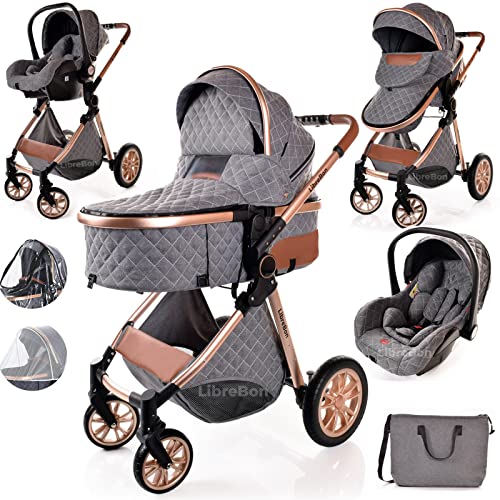Transitioning from Pram to Stroller: A Comprehensive Guide for Parents
Navigating the world of baby equipment can be frustrating for new moms and dads, especially when it concerns selecting between prams and strollers. Both serve vital functions, however they are created for different needs and phases of a kid's development. This post aims to inform parents about the transition from prams to strollers, describing the benefits and considerations while providing useful ideas.
Understanding Prams and Strollers
Before diving into their distinctions, it's crucial to comprehend what constitutes a pram and a stroller.
Prams:
A pram, short for perambulator, is normally developed for infants as much as around 6 months old. It includes a flat, padded sleeping location and is mainly planned for transporting very children. Prams are designed for convenience and security, as newborns need to lie flat to support their spinal column and organs.
Strollers:
Strollers, or pushchairs, are developed for slightly older kids who can stay up unaided. They can be found in numerous styles and configurations, from lightweight umbrella strollers to heavier-duty designs ideal for rough surfaces. Strollers are more versatile and simpler to maneuver in crowded areas, making them a popular option for active households.
Advantages of Transitioning from Pram to Stroller
- Increased Mobility and Convenience
Strollers are typically lighter and more compact than prams, making them easier to navigate through shops, public transportation, and crowded areas. A lot of strollers can fold easily, enabling practical storage. - Versatility for Different Activities
Modern strollers frequently include several setups and can accommodate various activities, including running, outdoor experiences, and shopping trips. Pram Chair can likewise adjust to suit children of various ages and weights. - Improved Child Comfort and Safety
Lots of strollers now come equipped with innovative safety features, such as five-point harnesses and reclining seats, ensuring that older babies and young children stay comfy and safe throughout outings. - Economical Solution
Instead of acquiring both a pram and a stroller, households can buy a premium stroller that satisfies the needs of their growing kid, potentially saving money in the long run.
When to Make the Transition
The transition from a pram to a stroller generally occurs when the child reaches around six to seven months of age or when they can sit up unassisted. However, numerous factors can influence this shift, including:
- Child's Development: If the child reveals indications of wanting to explore their surroundings, it may be time to change to a stroller.
- Household Lifestyle: Active families may need a stroller sooner to accommodate outings and travel.
- Convenience: Observe the kid's comfort level. If they appear cramped in a pram or are ending up being more active, it's time to think about a stroller.
Selecting the Right Stroller
Picking the best stroller needs careful factor to consider of a number of aspects:
| Factor | Description |
|---|---|
| Safety Features | Try to find sturdy construction, effective brakes, and harness systems. |
| Weight and Foldability | Choose a light-weight stroller that is easy to fold and transport. |
| Age Appropriateness | Ensure the stroller is fit for your child's age, weight, and height. |
| Maneuverability | Evaluate how easily the stroller moves and turns, specifically in congested areas. |
| Storage Space | Consider the storage capacity underneath the stroller and the size when folded. |
| Adjustability | Look for strollers with adjustable features, such as seat recline and manage height. |
FAQs about Transitioning from Pram to Stroller
Q: Is it necessary to change to a stroller?A: While it's not necessary, switching to a stroller usually offers more adaptability and ease for both moms and dad and kid as they grow. Q: What includes must I focus on
in a stroller?A: Prioritize security functions, weight, foldability, and storage capacity based upon your lifestyle and activities with your kid. Q: Can I use a stroller for newborns?A: Some strollers can accommodate infant safety seat or
have flat reclining seats, making them appropriate for
newborns. Constantly check the manufacturer's standards. Q: How can I guarantee my kid is comfy in a stroller?A: Look for strollers with cushioned seats, several recline positions, and adjustable leg rests to accommodate your kid's convenience. Q: What are the best types of strollers available?A: Popular types include umbrella strollers, jogging strollers, travel system strollers, and convertible strollers, each dealing with differentneeds. Tips for a Smooth Transition Test Out Different Models: Before dedicating to a purchase, physically test different strollers to see which one fits both you and your kid best. Include Your Child:
If they are old enough, enable your
child to try different strollers to see which they discover most comfy. Read Reviews: Consider looking at online reviews and suggestions from other moms and dads to much better notify your choice
. Plan for Storage and Transport: Factor in how the stroller will fit into your cars and truck or home storage space to avoid future inconveniences.
- Assess Your Activities: Think about where and how you prepare to utilize the stroller-- city locations may need a various type compared to rural or off-road settings.
- Transitioning from a pram to a stroller is a crucial milestone in a child's life and a considerable choice for parents. By comprehending the differences and
benefits of each, moms and dads can make educated options that will support their family's way of life and their child's development. Equipped with the right details, moms and dads can with confidence browse this shift and
ensure that their kid is safe, comfortable, and prepared for all the experiences ahead.

